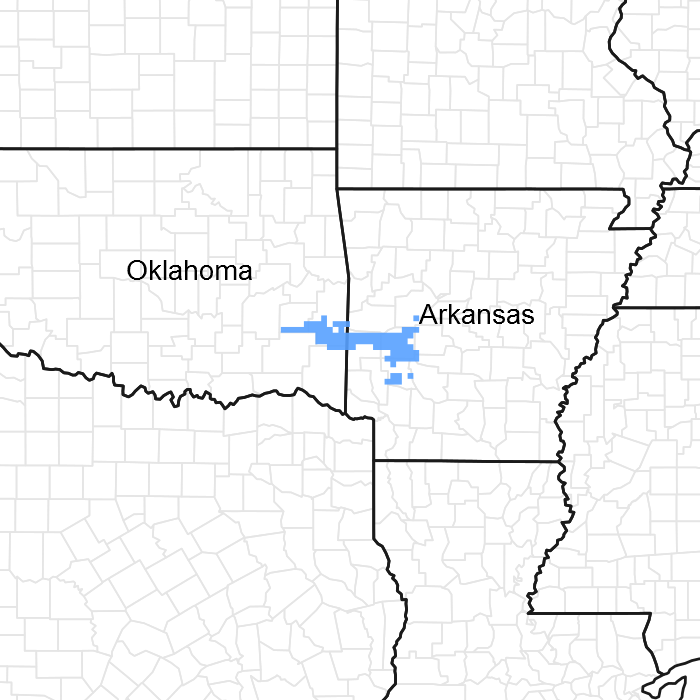
Natural Resources
Conservation Service
Ecological site NX119X01Y019
Rarely Flooded Terrace
Last updated: 9/22/2023
Accessed: 12/21/2025
General information
Provisional. A provisional ecological site description has undergone quality control and quality assurance review. It contains a working state and transition model and enough information to identify the ecological site.

Figure 1. Mapped extent
Areas shown in blue indicate the maximum mapped extent of this ecological site. Other ecological sites likely occur within the highlighted areas. It is also possible for this ecological site to occur outside of highlighted areas if detailed soil survey has not been completed or recently updated.
MLRA notes
Major Land Resource Area (MLRA): 119X–Ouachita Mountains
Major Land Resource Area 119, the Ouachita Mountains, is in Arkansas and Oklahoma. This MLRA is about 11,885 square miles (30,800 square kilometers). Hot Springs National Park and the Ouachita National Forest reside in this MLRA.
This MLRA is located in the Ouachita Mountains section of the Ouachita Province of the Interior Highlands. The steep mountains are underlain by folded and faulted sedimentary and metamorphic rocks. Most of the valleys are narrow and have steep gradients while wide terraces and flood plains border the Ouachita River. Elevation ranges from 130 feet (40 meters) in the bottomlands to 2,670 feet (810 meters) on the mountain peaks.
These steep mountains are underlain by folded and faulted formations, dominantly of shale and sandstone. Ordovician-age shale and sandstone are included in the Collier Shale, Crystal Mountain Sandstone, and Womble Shale. Mississippian-age shale, sandstone, novaculite, and chert are included in the Arkansas Novaculite and the Stanley Shale. Pennsylvanian-age shale, slate, quartzite, and sandstone are included in the Jackfork Sandstone, Johns Valley Shale, and upper Atoka Formations. Alluvial deposits of silt, sand, and gravel are on the wide terraces and flood plains that border the Ouachita River.
The dominant soil orders in this MLRA are Ultisols and Inceptisols. The soils in this MLRA have a thermic soil temperature regime, a udic soil moisture regime, and mixed or siliceous mineralogy.
Ecological site concept
The Rarely Flooded Terrace ecological site is in river valleys along terraces. The soils associated with this site are very deep and formed in alluvium derived from sandstone and shale. This site has slopes between 0 and 3 percent with elevations ranging from 300 to 1,000 feet (91 to 304 meters). Important abiotic characteristics associated with this site are rare flooding events occurring for very brief to brief durations.
Associated sites
| NX119X01Y012 |
Drainageway This ecological site is differentiated from the Rarely Flooded Terrace Ecological Site by an irregular decrease in organic matter throughout the soil profile and occasional to frequent flooding events. |
|---|
Similar sites
| NX119X01Y018 |
Poorly Drained Flood Plain This ecological site is differentiated from the Rarely Flooded Terrace Ecological Site by very poor drainage characteristics. |
|---|
Table 1. Dominant plant species
| Tree |
(1) Pinus echinata |
|---|---|
| Shrub |
(1) Betula nigra |
| Herbaceous |
(1) Andropogon gerardii |
Legacy ID
F119XY019AR
Click on box and path labels to scroll to the respective text.
Ecosystem states
| T1A | - | Tree removal, brush management, plantation tree establishment and management. |
|---|---|---|
| T1B | - | Tree removal, mechanical and chemical woody vegetation suppression, tillage, introduce annual or perennial forage species. |
| T2A | - | Woody species removal, prescribed fire, seeding, and grazing. |
| T3A | - | Forage species suppression, brush management, plantation tree establishment and management. |
State 1 submodel, plant communities
| 1.1A | - | Less water during vegetation establishment. |
|---|---|---|
| 1.2B | - | More water during vegetation establishment. |
| 1.2A | - | Less water during vegetation establishment. |
| 1.3A | - | More water during vegetation establishment. |
| 1.3B | - | More water during vegetation establishment. |